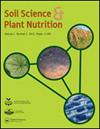不同农田土壤微生物量钾池大小
IF 1.8
4区 农林科学
Q3 ENVIRONMENTAL SCIENCES
引用次数: 1
摘要
钾(K)是包括土壤微生物在内的各种生物细胞内的主要阳离子。本研究首次揭示了不同农田土壤微生物细胞钾库大小及不同土地利用方式和有机质施用对其含量的影响。测定了不同地区不同管理方式的稻田土壤以及旱地、果园和牧场土壤的微生物量钾,估算了农田土壤微生物细胞中钾库的大小。稻田土壤微生物量钾含量在9 ~ 65 mg K kg−1之间,稻田土壤类群间无差异。草地土壤的生物量钾含量(183 ~ 187 mg K kg−1)高于稻田、旱地(8 ~ 51 mg K kg−1)和果园(25 ~ 50 mg K kg−1)。所有土壤微生物量钾与交换态钾的平均比值为0.25,水田(0.31)和牧场(0.53)高于旱地(0.06)和果园(0.08)。微生物量钾与微生物量碳、氮含量呈显著正相关。施用有机质显著增加了农田土壤微生物钾量。这些结果表明,微生物量钾作为钾库在作物钾供应中起着重要作用,水田和牧场土壤中微生物量钾对作物钾源的贡献可能相对高于旱地和果园土壤。本文章由计算机程序翻译,如有差异,请以英文原文为准。
Pool size of microbial biomass potassium in various farmland soils
ABSTRACT Potassium (K) is the major intracellular cation in all kinds of organisms including soil microorganisms. This study for the first time presented the potassium pool size in microbial cells in various farmland soils and the effect of land use and organic matter application on the contents. Microbial biomass potassium was determined for several paddy field soils under various managements in different areas, together with some upland, orchard, and pasture field soils, to estimate the potassium pool size in microbial cells in the farmland soils. The contents of microbial biomass potassium ranged from 9 to 65 mg K kg−1 soil in the paddy field soils and showed no difference among soil groups of the paddy fields. The biomass potassium content was higher in the pasture field (183–187 mg K kg−1 soil) than that in the paddy, upland (8–51 mg K kg−1 soil) and orchard (25–50 mg K kg−1 soil) field soils. The average ratio of microbial biomass potassium to exchangeable potassium was 0.25 for all the soils and the average values for paddy field (0.31) and pasture field (0.53) soils were higher than those for upland field (0.06) and orchard field (0.08) soils. Positive correlations were found between the contents of microbial biomass potassium and microbial biomass carbon and nitrogen. Application of organic matter significantly increased microbial biomass potassium in the farmland soils. These findings indicate that microbial biomass potassium plays an important role in potassium supply to crops as a reservoir of potassium and also suggest that the contribution of microbial biomass potassium to the potassium source for crops could be relatively higher in paddy field and pasture field soils than upland field and orchard field soils.
求助全文
通过发布文献求助,成功后即可免费获取论文全文。
去求助
来源期刊

Soil Science and Plant Nutrition
农林科学-农艺学
CiteScore
4.80
自引率
15.00%
发文量
56
审稿时长
18-36 weeks
期刊介绍:
Soil Science and Plant Nutrition is the official English journal of the Japanese Society of Soil Science and Plant Nutrition (JSSSPN), and publishes original research and reviews in soil physics, chemistry and mineralogy; soil biology; plant nutrition; soil genesis, classification and survey; soil fertility; fertilizers and soil amendments; environment; socio cultural soil science. The Journal publishes full length papers, short papers, and reviews.
 求助内容:
求助内容: 应助结果提醒方式:
应助结果提醒方式:


